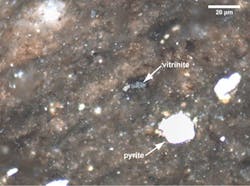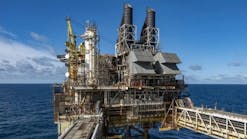Reflectance standard adopted for dispersed vitrinite in sediment
A new American Society for Testing & Materials standard test method for measurement of the reflectance of vitrinite dispersed in sedimentary rocks has been developed by an international committee of technical experts from government agencies, academia, industry, and consultancies.
Anticipated users of the new D7708-11 standard include government, academic, and service laboratories. The standard will be used as the prescribed method for the dispersed vitrinite reflectance accreditation program of the International Committee for Coal and Organic Petrology (ICCP), which includes some 40 laboratories worldwide.
The test method is predicted to be most relevant for shale gas plays where precise information concerning thermal maturity is considered key to successful basin analysis. Anticipated future improvements to the standard include the creation of quantified reproducibility and repeatability values through interlaboratory round robin exercises and the development of a supplemental on line image atlas of dispersed organic matter in sedimentary rocks to aid in the identification of indigenous vitrinite.
This product grew from the efforts of the ICCP Identification of Primary Vitrinite Working Group and is the result of an international partnership between members of ICCP, ASTM, the American Association of Petroleum Geologists, and The Society for Organic Petrology. The new consensus standard is available for purchase (http://www.astm.org/Standards/D7708.htm) and is included in the 2011 Annual Book of ASTM Standards, Vol. 05.06, Gaseous Fuels; Coal and Coke, which can be obtained as a free yearly benefit to ASTM members.
Development of the new test method, ASTM D7708-11, began in 2008 with a survey of common practices used in laboratories that routinely measure the reflectance of dispersed vitrinite in shales. The test method writing committee was identified from among the survey respondents, and the existing ASTM coal vitrinite reflectance standard, ASTM D2798, was used as an outline for the new test method.
Significant changes from the coal standard include:
• Specialized terminology to include recycled vitrinite, zooclasts, solid bitumens, and marine algae.
• Discussion of potential for vitrinite suppression and retardation in certain conditions.
• Inclusion of fluorescence observation and resulting changes to equipment description and procedure.
• Addition of reporting requirements, including type and quality of sample preparation, observation of fluorescence, and consideration of supporting data and information.
The new standard was successfully balloted through the subcommittee and D05 main committee levels of the ASTM vetting process with no negative vote received. However, users of the standard and other interested parties can bring comments and concerns to the attention of ASTM subcommittee D05.28, Petrography of Coal and Coke, which is responsible for the maintenance and revision of this and other ASTM petrography standards.
OGJ readers who would like to contribute to consensus standards development within subcommittee D05.28 are encouraged to contact Paul Hackley, US Geological Survey ([email protected]), for more information.
More Oil & Gas Journal Current Issue Articles
More Oil & Gas Journal Archives Issue Articles
View Oil and Gas Articles on PennEnergy.com


